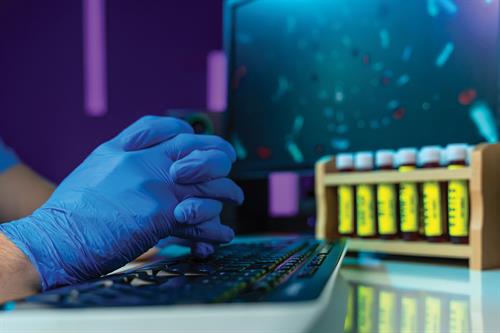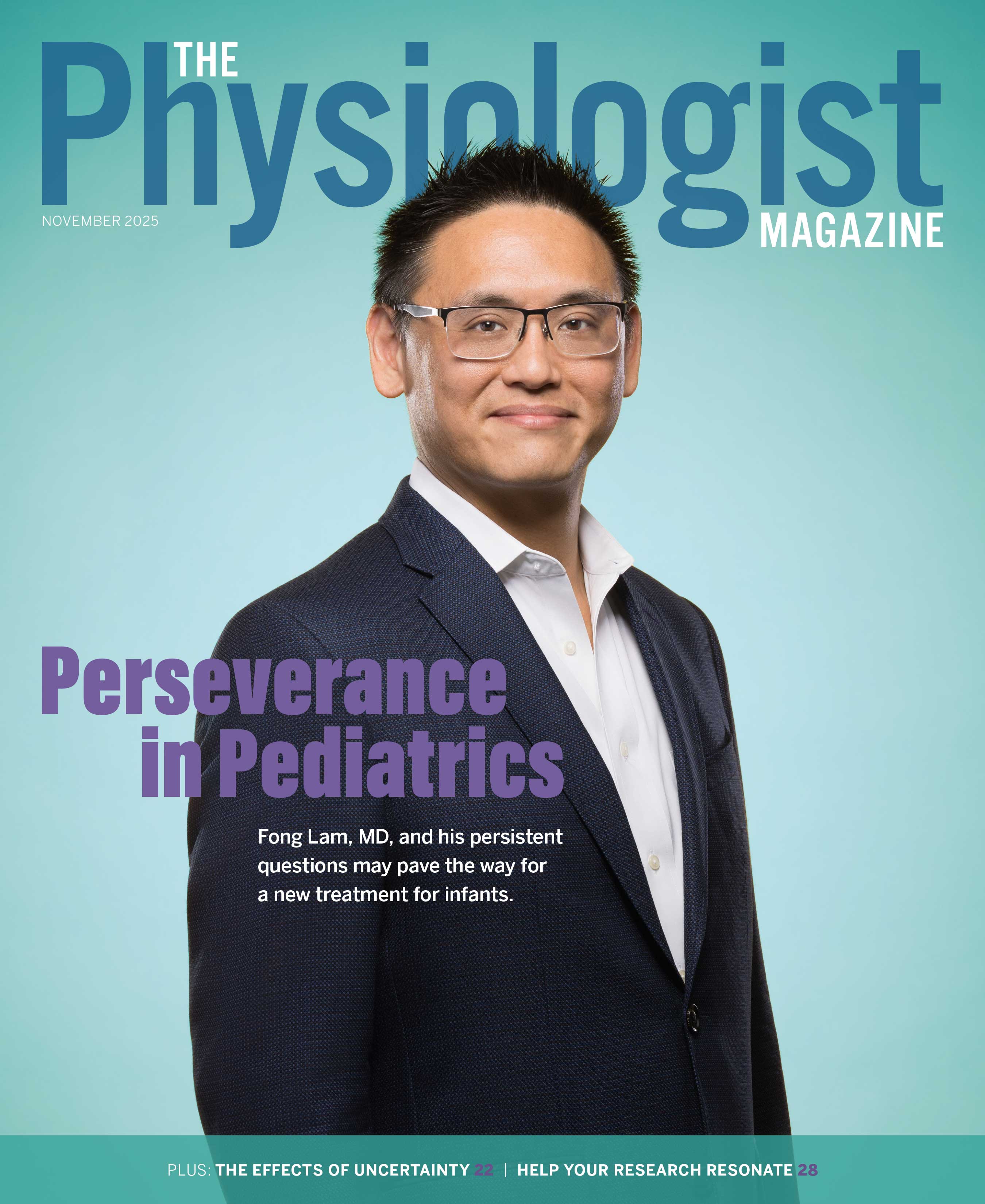Idle Labs
The COVID-19 pandemic has drastically disrupted physiology labs and research, forcing scientists to grapple with a common theme: uncertainty.
By Dara Chadwick

The unexpected comes with the territory in research science. But even those who expected COVID-19 to have some impact on life in the lab say the disruption to their research has gone far beyond what they anticipated. While most labs have plans for managing operations through natural disasters and unforeseen complications, many have made on-the-fly adjustments that include remote work, physical distancing and project pivots.
Lila Wollman, PhD, a postdoctoral research associate in the Department of Physiology at the University of Arizona in Tucson, says her lab has been able to continue some work by shifting schedules. "There are no in-person classes, but research hasn't completely closed down," she says. "We had to submit a waiver and get specific approval to not shut down our lab. We have a waiver in place, and we completely stagger our schedules so no two people are ever overlapping in the lab."
It's been working well, she says. While there are other labs on her floor, the lab next door is closed. Wollman comes in from 7:30 a.m. to about 12:30 p.m. three days a week. The lab's graduate student comes in after 1 p.m., and the lab technician comes in on the other two days.
"Occasionally, I'll see someone way down the hall, but when I go to work, I truly am social distancing," Wollman says. "We're committed to safety first. If I felt like I wasn't able to maintain social distancing, I'd definitely have to reevaluate what I was doing."
Wollman says she would typically be in the lab all day, every day, using a rat model to study the control of breathing and how it's affected by nicotine exposure during development. "Now, I'm working about 15 to 20 hours a week in the lab," she says, estimating that her personal productivity in experiments has been cut in half.
Adrienne Wilburn, who is pursuing a PhD in immunology at the University of Cincinnati in Ohio and is housed in the Lewkowich Research Lab at Cincinnati Children's Hospital Medical Center, says she's able to go into the lab as needed. Her work, focused on early disruption of the microbiome and its influence on asthma and lung development, uses a mouse model to monitor airway function and lung development in pregnant mice.
"Children's has been really great," she says. "They've left it up to the principal investigators to decide which experiments are critical and which can be ended sooner or sidelined. I'm at a part of my project where I can go in just a few times a week
to check on the mice and that's sufficient. But I've been working at home mostly."
An Uncertain Path
Other researchers have seen their work come to a halt. "Everything's on hold right now," says Sonnet Jonker, PhD, associate professor in cardiovascular medicine at the Oregon Health & Science University School of Medicine in Portland. Jonker, who studies cardiac development in the perinatal period, uses sheep to study the physiology that drives anatomical changes in the heart during fetal development.
"We're able to do surgery on pregnant ewes and place catheters, flow probes and other devices," she says. "We let them recover from surgery and then we measure physiological parameters continuously for several weeks during the period of pregnancy we're interested in. This is really quite unavailable in other animal models."
But her sheep model has proven challenging in light of COVID-19's impact, says Jonker, who serves as chair of the APS Animal Care and Experimentation Committee. "We're in a rather unique situation with large animals," she says. "To do any work with sheep, including euthanizing them, we have to have multiple people there. You can't do that work alone. Throughout the nation, policies related to animal work are really geared toward rodents because they are the overwhelming majority. Universities are having to approach large animals on a case-by-case basis."
Because sheep are seasonal breeders, Jonker does most of her animal work from October through April, so that portion of her work was winding down as COVID-19 closures began. "We're also a hospital, so the university was backing off any work that used personal protective equipment (PPE) on the research side," she says. "Our comparative medicine department actually donated tens of thousands of masks to the hospital side."
Jonker was able to petition the university for an exemption for one animal in which research was ongoing and the plan couldn't be changed, she says. "We have critical function employees designated, so we had a reduced staff that went in to do that work," she says. Normally, her lab would have been doing polymerase chain reaction, cell culture and histology work by May, but none of that could be done. As of early May, "we're not really generating any new data or doing any new work."
But Jonker says the biggest issue she's facing is uncertainty. "Sheep gestation is 147 days long, and we do most of our work in the last third of gestation and a bit in the neonatal period," she says. "To start our work at the regular time in the fall, our supplier needs to start breeding the sheep in May. We have no idea where this is going. We have no idea when we're going to be able to go back to work."
Likewise, Gregory Funk, PhD, professor in the Physiology Department at the University of Alberta in Edmonton, Canada, is facing uncertainty around his animal models. Funk uses rat and mouse models to study networks in the brain stem that produce and control breathing, as well as how those networks change during development and respond to hypoxia.
"The university is open for essential services and essential research," he says, adding that he applied for and received an exemption for one of his studies. "I have one person in the lab one day a week to complete a longitudinal study with a transgenic mouse line that had already started when the closures were introduced. Aside from that, my lab is closed, and that's the case for most labs on campus. Staggering schedules was not considered a viable option. So, aside from a few exemptions like mine, the research has stopped."
That creates a challenge for future work, according to Funk. "Because we need neonates, we typically have a lot of breeding pairs run every week," he says. "That's all been scaled back to maintenance of the colonies. When we get back, we can't just start
up right away because we won't have animals. They will have to go through at least one breeding cycle to get the colony back up to size. Once we get back in the lab, it's probably going to be another six to eight weeks before we're really doing experiments
again."
Ripple Effects
Funk says the uncertainty of the lab's status is taking a toll on graduate students who tend to be on a timeline, with limited resources and income. "I run our graduate program in the Physiology Department, and a big question is how to deal with this in the context of graduate students, especially those who were about to complete experimentation," he says. "We're trying to be as accommodating as possible, but we have to maintain standards for the program."
Funk praised the Canadian Institutes of Health Research (CIHR) for issuing guidance to research labs who use grant money to pay research staff. "They came out with a statement saying that supporting our research workforce is a priority and that paying these staff is an eligible expense even though most of them are not in the lab doing research right now," he says.
Funding is another issue some researchers with shuttered labs will need to address, Funk adds. CIHR runs two grant rounds each year, and the last round at the beginning of March was canceled. "People who had grants submitted can take them back and revise them or leave them in and they'll be added to the pool for the next competition," he says. "But one entire grant round was removed from the system. Some people are going to have a gap in funding if their grants didn't renew last time."
The unknowns of a still-evolving situation make planning difficult, but Jonker and her team are trying to put together contingency plans. "We're asking 'what if we can't get the PPE we need for surgeries and we order these animals, what can we do?'" she
says. "If we can't gather in groups of more than three, what can we do? If we can only get two people in the lab at the same time—if that's the most they'll allow us—then how do we need to change what we do in order to make the work
happen?"
Finding the Positive
Jonker has been talking with colleagues about what can be done while the lab is closed. "Rather than dwelling at length on what we can't do or what we've lost, we're thinking about ways to move forward," she says.
Funk, who canceled his attendance at a conference in Switzerland as COVID-19 was beginning to spread, says at that time he told everyone in his lab to start doing as many experiments as they could. "I told them we will not be here for much longer," he says. "So, people just started cranking as much as they could, knowing they could do the data analysis later. That helped."
Wollman knows how lucky she is to be able to continue her experiments. "It's great to be able to go into work, even if it's just a couple of days a week," she says. "It helps maintain some kind of normalcy and routine. I have grants I want to apply for that I've been thinking about for a while. I'm close to being at a point where I'm going to need to stop and just write. This has forced me to get started, and that's not necessarily a bad thing."
As for Wilburn, she's using this time to focus on thinking about her thesis. Although a conference she was supposed to attend was canceled, she's reading papers, organizing and collating data, and thinking about ways to do her work that will be useful down the road, she says.
Still, it can be tough to tune out the ever-present anxiety. "I know graduate students who are at a standstill and early-career faculty who are trying to get their labs established and can't make any progress on their research," Wollman says. "Who knows how long all of this is going to be going on? I think it's realistic to think it will be going on for a while and that some of the things that are going well now might be impacted later."
The Physiologist Magazine
Read the Latest Issue
Don’t miss out on the latest topics in science and research.
Contact Us
For questions, comments or to share your story ideas, email us or call 301.634.7314.


